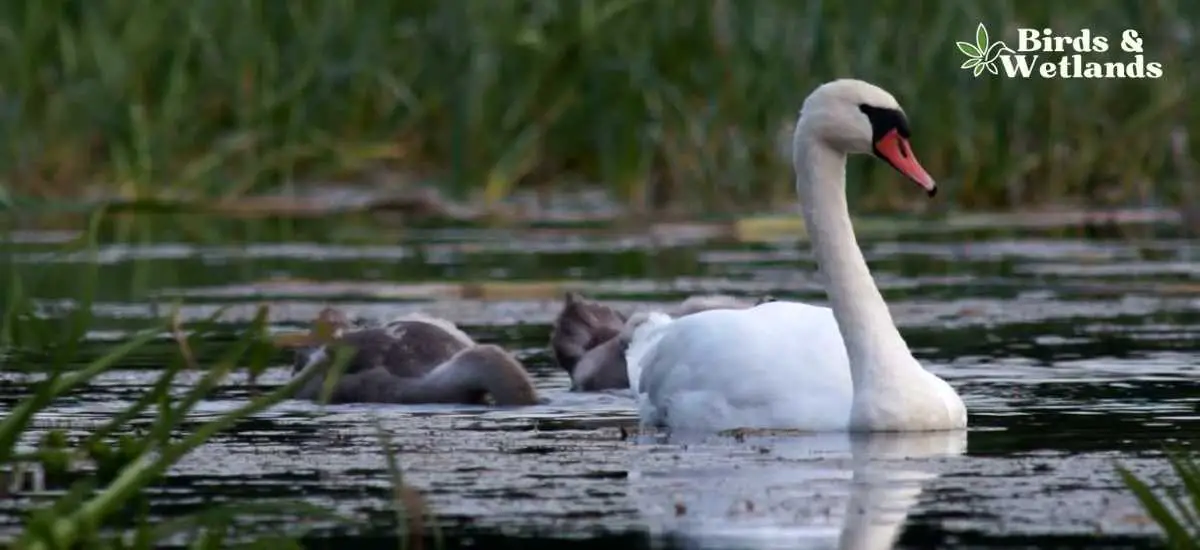Did you know that North America is home to three unique species of swans? From their serene beauty to their fascinating habits and behaviors, swans have captivated the hearts of many.
In this comprehensive guide, we delve into the world of North American swans and explore their fascinating world. From the mute swan to the tundra swan and the whooping swan, we’ll cover the different types of swans found in North America and their migration patterns.
We’ll also examine their feeding and breeding habits, as well as the social structures that make these birds truly special. But not all is well for North American swans. We’ll also take a closer look at the threats these magnificent birds face and the conservation efforts underway to protect them.
So sit back, relax, and get ready to be amazed by the swans of North America!
Types of Swans in North America
There are three swan species in North America; the native trumpeter and tundra swans (previously known as whistling swan), as well as the non-native mute swan. The trumpeter swan is the largest waterfowl in North America and the world’s largest swan. The fourth species, the Whooper Swan is sometimes found in Alaska but it is not a native species.
Most of the Swans in America are pure white but believe it or not, black swans exist (and some of these swans are kept as pets).
Tundra Swan
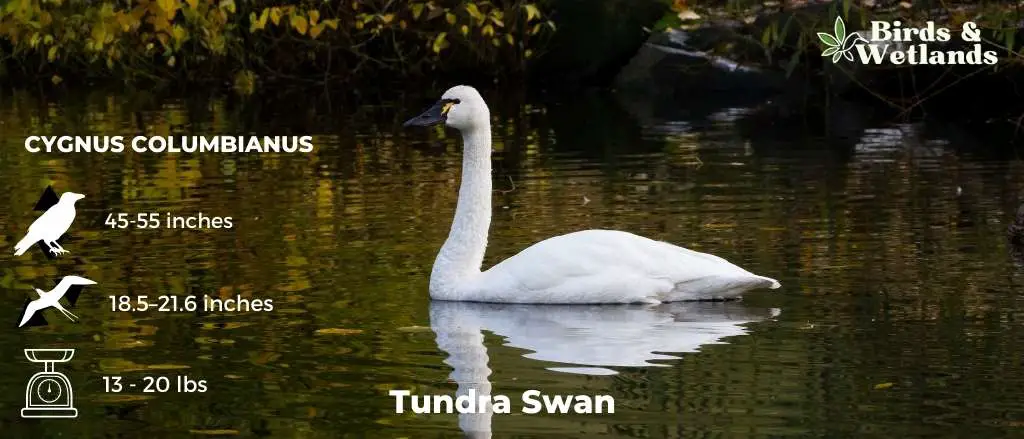
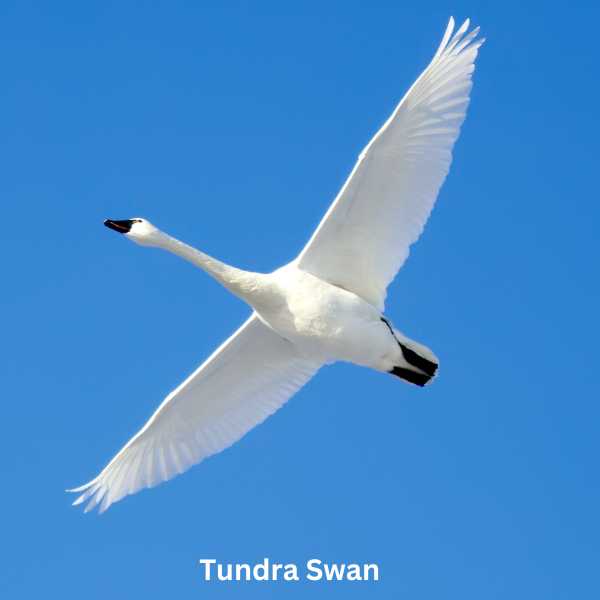
Listen to Tundra Swan
Scientific Name: Cygnus columbianus
Length: 45–55 in
Wingspan: 18.5–21.6 in
Weight: 13 – 20 pounds
The Tundra Swan is a large, graceful species of waterfowl known for its elegant appearance, long migratory journeys, and melodic calls.
Appearance: Tundra Swans, as the name suggests, are predominantly white, which aids in camouflage against the snowy landscapes of their breeding grounds. They have a long neck, a black bill, and black feet. One of the distinguishing characteristics of Tundra Swans is a small yellow spot near the eye, which can vary among individuals.
Diet: Tundra Swans primarily feed on plant matter, including aquatic vegetation, roots, tubers, and grains. They forage by dipping their long necks under the water in shallow areas, or by upending in deeper waters.
Reproduction: Tundra Swans breed in the high Arctic tundra, near ponds and lakes. The female builds the nest and lays a clutch of about 3 to 5 eggs, which she incubates alone for roughly a month.
Mute Swan
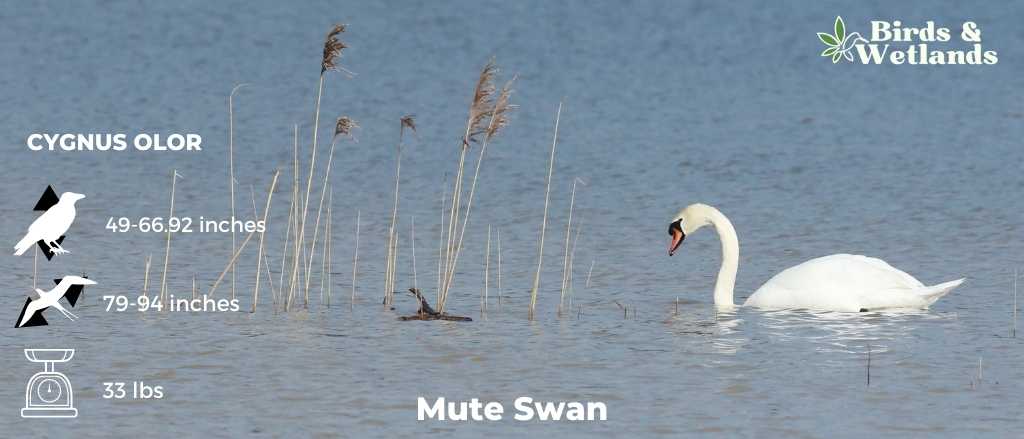

Listen:
Scientific Name: Cygnus olor
Length: 125 – 170 cm
Wingspan: 200 to 240 cm
Weight: 33 lb
The Mute Swan is an elegant and recognizable waterfowl species, well-known for its serene beauty and strikingly graceful presence on many of North America’s waterways.
Appearance: Mute Swans are large birds with a long, curved neck and a distinctive orange beak with a black knob at the base. They’re primarily white in color, with males (known as cobs) and females (known as pens) looking similar.
Diet: Mute Swans are herbivores, mainly feeding on a variety of submerged aquatic vegetation. They use their long necks to reach plants growing in deeper waters.
Reproduction: Mute Swans usually mate for life. Their nests are large and located near the water’s edge. Females lay a clutch of 5 to 7 eggs, which are incubated for about a month before hatching.
Trumpeter Swan
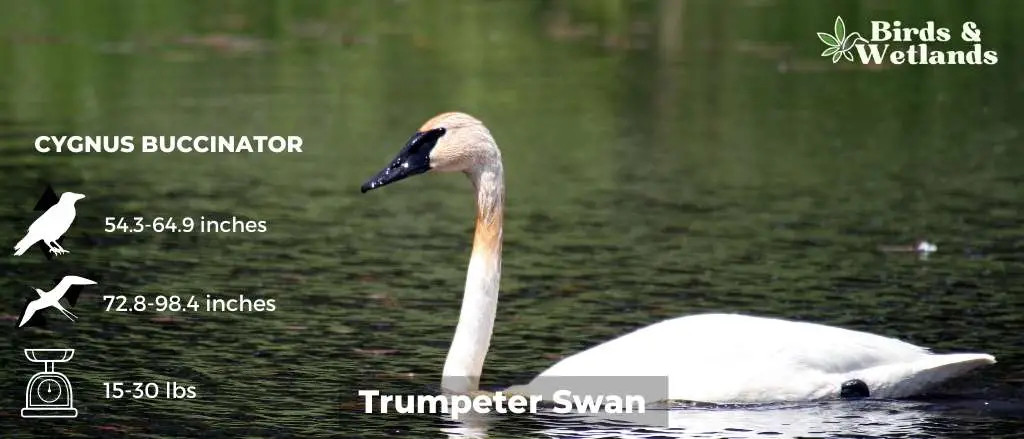
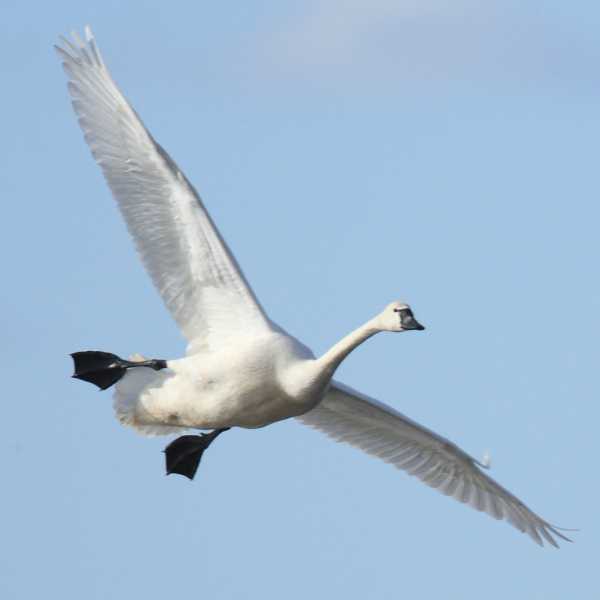
Listen:
Scientific Name: Cygnus buccinator
Length: 4 ft 6 in – 5 ft 5 in
Wingspan: 185 to 250 cm
Weight:7–13.6 kg
The Trumpeter Swan is one of the heaviest flying birds in North America, known for its impressive size and majestic presence.
Appearance: The Trumpeter Swan is predominantly white, with a long, elegant neck and a black bill. The adults are distinguishable from other swans by their straight, not curved, neck when swimming. They have a wingspan that can extend up to 10 feet, making them a truly magnificent sight to behold.
Diet: These swans are herbivores and primarily feed on aquatic plants. They forage in shallow water, often submerging their heads and necks to reach underwater vegetation. They may also graze on land when available.
Reproduction: Trumpeter Swans usually nest near water bodies, creating large nests made from plant material. The female lays 3 to 5 eggs and the incubation period lasts about a month.
Protection and Conservation of Trumpeter Swans
The Trumpeter swan is a large, majestic bird that was once on the brink of extinction. The passage of the Migratory Bird Treaty Act of 1918 provided protection to trumpeter swans and other birds, helping to curb illegal killing. This was crucial in the efforts to save the species.
By 1932, the trumpeter adult swans population had declined to just 70 birds worldwide, with a large concentration of these birds found near Yellowstone National Park. In response to this, the Red Rock Lakes National Wildlife Refuge was established in 1935 in Montana’s Centennial Valley. This refuge was established to protect nearly half of the world’s known trumpeter swans, which were found in the Greater Yellowstone ecosystem.
The establishment of Red Rock Lakes National Wildlife Refuge and other national wildlife refuges marked a turning point in the efforts to save the trumpeter swan. With proper protection and conservation efforts, the species has made a remarkable recovery, with populations now found across North America.
Today, the Trumpeter Swan Society works to protect and conserve the species through habitat protection and restoration, research, and public education. These efforts have helped to ensure the survival of this magnificent bird, and have allowed us to enjoy its beauty for generations to come.
The Trumpeter swan is a migratory bird, with some southern populations remaining non-migratory. Northern Trumpeters, however, undertake an annual migration to more temperate climates.
In late fall, as waters begin to freeze, the northern Trumpeters move south in flocks, often in a distinctive V-formation and flying low. This migration is primarily a daytime event and is a spectacular sight to behold.
In spring, the migration begins early, with birds often reaching their nesting territory before the waters are free of ice. This allows the birds to establish their territories and begin breeding as soon as conditions permit.
The migration of Trumpeter swans is a testament to the birds’ resilience and adaptability. By undertaking these annual migrations, they are able to ensure their survival and continue the species’ cycle of life.
Whooper Swan Species in US
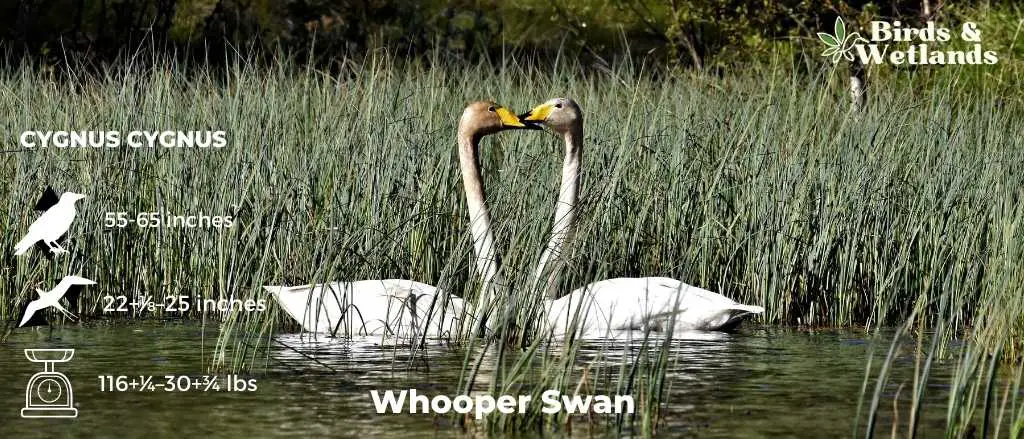
Listen to Whooper Swan
The whooper swan is a large, black-and-white waterfowl that live in the northern hemisphere. It has a large, white bird that is almost entirely covered in black and gray plumage. The wings are long and pointed, with a black stripe across them. The beak is orange-yellow, with a black tip. The legs and feet are also yellow. The female of this species is slightly smaller than the male, with a more rounded head.
The bird’s habitat is often lakes or other bodies of water with shallow shores where it can easily wade in shallow waters to feed. The whooper swan has many interesting facts about its diet and behavior. Its diet consists of small fish, frogs, and insects like dragonflies.
The whooper swan can be found on lakes and rivers in Europe and Asia. It prefers to live near water and feeds on aquatic vegetation, but it also eats other plants as well as insects when they’re available.
The Whooper Swan lives on lakes and rivers in the summer months, but migrates to warmer climates for the winter months. They prefer fresh water lakes because they need high levels of dissolved oxygen during their long flights.
These birds typically mate for life unless one partner dies or disappears for some reason; then the survivor will seek out another mate within two years’ time at most.
The current population of whooper swans is estimated at between 1 million and 2 million birds worldwide.
Scientific Name: Cygnus cygnus
Height: 140–165 centimeters (55–65 inches)
Wingspan: 56.2–63.5 cm (22+1⁄8–25 in)
Weight: 7.4–14.0 kilograms (16+1⁄4–30+3⁄4 pounds)
The whooper swan is a large, migratory bird that is native to the Northern Hemisphere. While it is primarily found in Europe and Asia, a small population of whooper swans breeds in Alaska and winters in the western United States, but it is not considered one of the native swans.
The whooper swan is a charismatic bird that is well-loved for its beauty and vocalizations. It is larger and more powerful than the more commonly seen tundra swan, and is easily recognizable by its long neck and distinctive whooping call.
Despite their beauty, whooper swans face challenges in their breeding and wintering habitats. In their breeding grounds, they face threats from habitat loss and degradation, while in their wintering grounds, they face challenges such as lead poisoning from ingestion of lead shot and other environmental pollutants.
Conservation efforts are underway to protect whooper swans and their habitats. These efforts include habitat restoration, lead reduction programs, and research to better understand their biology and population trends.
General Facts About American Swans
Here are some fun facts about swans that you might not have known:
- Swans mate for life: Once swans find a mate, they form a bond that lasts for life and they will remain together until one of them dies.
- Swans can fly long distances: Swans are strong fliers and can fly up to 600 miles in a single day.
- Swans can be aggressive: While they are known for their graceful and serene behavior, swans can be quite aggressive, especially when they are protecting their nests or young, however, swans would not kill you.
- Swans have unique vocalizations: Swans make a variety of unique vocalizations, including honks, whistles, and grunts, that they use to communicate with each other.
- Swans have webbed feet but do not have claws: Swans have webbed feet that help them swim and navigate through the water. They also have long, powerful legs that they use to paddle through the water and to take off into flight.
- Swans can see in the dark and swans can land on land or on water, and whilst they are water birds swans do not have gills and do not have teeth.
- Swans prefer to take off in water, but don’t need water to take off, and naturally, swans are strong swimmers, but if you see swans swimming in circles, check if anything is wrong.
- Swans have a thick layer of feathers to survive cold weather.
- Swans prefer freshwater, but you can often see swans swimming in the sea.
- Swans have 24 or more neck vertebrae (swans have a backbone), whilst the eyes of the black swan (Cygnus atratus) are white but turns red during the breeding season.
Habitat and Distribution of Swans in North America
Understanding their habits and behaviors is key to appreciating the role they play in their ecosystems.
Swans are found in a variety of habitats in North America, including freshwater lakes, rivers, marshes, and coastal bays. Their habitats provide the birds with food, shelter, and a place to breed. A common question is can swans fly, and yes they can!
Swans are also known for their migration patterns, where they travel long distances in search of warmer climates and better food sources. Tundra Swans, for instance, travel thousands of miles each year from their breeding grounds in the Arctic to their wintering habitats in the United States and Mexico.
Despite their habitats providing vital resources, they are facing numerous threats and not just from predators. Human activities such as development, pollution, and overfishing have caused a decline in their populations. Climate change is also a major threat to their habitats, causing shifts in migration patterns and reductions in food sources.
Preserving swan habitats is crucial for their survival. This can be done by protecting wetlands, implementing sustainable fishing practices, reducing pollution, and promoting responsible land use. Additionally, educating the public about the importance of swan habitats and the threats they face can help create a more sustainable future for these magnificent birds.
Conservation and Management of Swans in North America
The populations of swans in North America have faced a historical decline due to hunting, habitat loss, and other human activities. This has led to a need for conservation and management efforts to protect and preserve these birds for future generations.
Current efforts to protect and conserve swans in North America include habitat protection, population monitoring, and implementation of hunting regulations. For instance, the Trumpeter Swan Society has been working to restore the population of this species through breeding and release programs, as well as habitat protection initiatives.
Despite these efforts, there are still challenges that need to be addressed for the effective conservation of swans. One major challenge is the ongoing loss of wetland habitats due to development and climate change. Another challenge is the limited resources and funding for conservation initiatives.
However, there are also opportunities for future conservation, such as working with private landowners to protect swan habitats, and increasing public awareness and education about the importance of conserving these birds. By addressing these challenges and taking advantage of these opportunities, we can ensure a sustainable future for the swans of North America.
The important of protecting the swan population is the reason why it is illegal to eat swan eggs in many states (depending on the swan species), even though swan eggs are edible.
Swan Feeding Habits
North American swans are omnivores, meaning they feed on both plants and small aquatic animals. They use their long necks to reach the bottom of ponds and lakes for aquatic vegetation, and also forage for food on land.
Trumpeter and Tundra Swans have been known to consume insects, snails, crustaceans, and even small fish. They also have a unique feeding technique where they upend in the water to reach food, using their feet to paddle themselves underwater.
Swan Breeding Behaviors
Swans are monogamous and mate for life. During the breeding season, they establish and defend a territory, and engage in courtship displays to attract a mate. Some breeds of swans like Tundra, are said to die of a broken heart or even swans can kill themselves when their mates die. Despite popular belief in a swan song, swans do not sing as they die.
Swans build large nests on the ground or in shallow water, using plant materials such as reeds, grasses, and feathers to line their nests.
The female swan incubates the eggs, while the male guards the nest. Once the cygnets hatch, both parents care for them and protect them from predators.
Swans do carry their young on their back for protection, but not whilst flying.
Remember when a swan has young cygnets or a nest, it can become territorial and dangerous to humans and other animals so stay away!
Mute Swan Populations
In recent years, several states in North America, including Michigan, have taken steps to regulate and reduce the population of mute swans. This is due to concerns about the impact of mute swans on native wildlife and their habitats.
Mute swans have been known to displace native birds, damage aquatic vegetation, and pose a threat to other wildlife, and some believe swans keep geese away.
To control the mute swan population, some states have implemented methods such as egg adding (to reduce mute swan cygnets), habitat modification, and direct removal. In addition, several states have banned the importation and release of captive mute swans. These efforts aim to maintain a balanced ecosystem and protect native wildlife and their habitats.
While these measures have proven effective in reducing mute swan populations, they have also sparked controversy and debate. Some people believe that the measures are necessary to protect native wildlife and their habitats, while others believe that the mute swans are a valuable part of our natural heritage and should be protected.
Migration Patterns of Swans
North American swans are migratory birds, meaning they travel long distances between their breeding and wintering grounds. Swans use a variety of cues such as day length, temperature, and food availability to determine when it’s time to migrate. The migration patterns of North American swans vary depending on the species. For example, the tundra swan migrates as far as 6,000 miles, while the mute swan migrates only short distances.
Swan Social Structures
Swans are social birds and live in large flocks. They communicate with each other through vocalizations and body language. In addition, swans have a hierarchical social structure, with dominant birds having priority access to food and mates. This social structure helps them maintain order and reduces competition within the flock.
Swan Symbolism & Culture
There is much Swan symbolism as they are often a symbol of grace, beauty, love, and purity in various cultures and traditions. It is also often associated with divinity and the afterlife.
In Greek mythology, the swan was linked to the god Zeus who took the form of a swan to seduce Leda, and in Hindu mythology, the swan is seen as the vehicle of the Hindu god Brahma.
In Christianity, the swan is a symbol of the soul and its beauty and purity, and in some cultures, the swan is associated with the idea of metamorphosis or transformation.
The image of two swans swimming together is also often used as a symbol of love and devotion.
Dreaming about swans can often have many meanings, depending on the context, we’ve taken a deep dive here.
FAQs on Swans North America
Where do swans live in North America?
Swans are found in a variety of habitats in North America, including freshwater lakes, rivers, marshes, and coastal bays.
Do swans migrate?
Yes, swans are known for their migration patterns, where they travel long distances in search of warmer climates and better food sources, often seen alongside snow goose populations.
What do swans eat?
Swans feed on aquatic plants, small fish, insects, and crustaceans.
How do swans reproduce and raise their young?
Swans typically nest near the water and lay eggs, which they incubate for around 35 days. The young, called cygnets, are cared for and fed by both parents.
What are some threats to swans in North America?
Threats to swans in North America include habitat loss, pollution, overfishing, hunting, and climate change. The wildlife service is trying to combat these.
What is being done to conserve swans in North America?
Conservation efforts for swans in North America include habitat protection, population monitoring, hunting regulations, and breeding and release programs, however for adult birds in mute swans many states are actively trying to control their population.s
How can I help protect and conserve swans in North America?
You can help protect and conserve swans in North America by supporting conservation organizations, participating in wetland habitat preservation initiatives, and reducing your impact on the environment through actions like reducing pollution and reducing your carbon footprint.
Remember swans are a wild animal, you cannot buy most breeds of swan, nor can you legally eat keep swans as pets, eat swan eggs or even eat swan meat.

